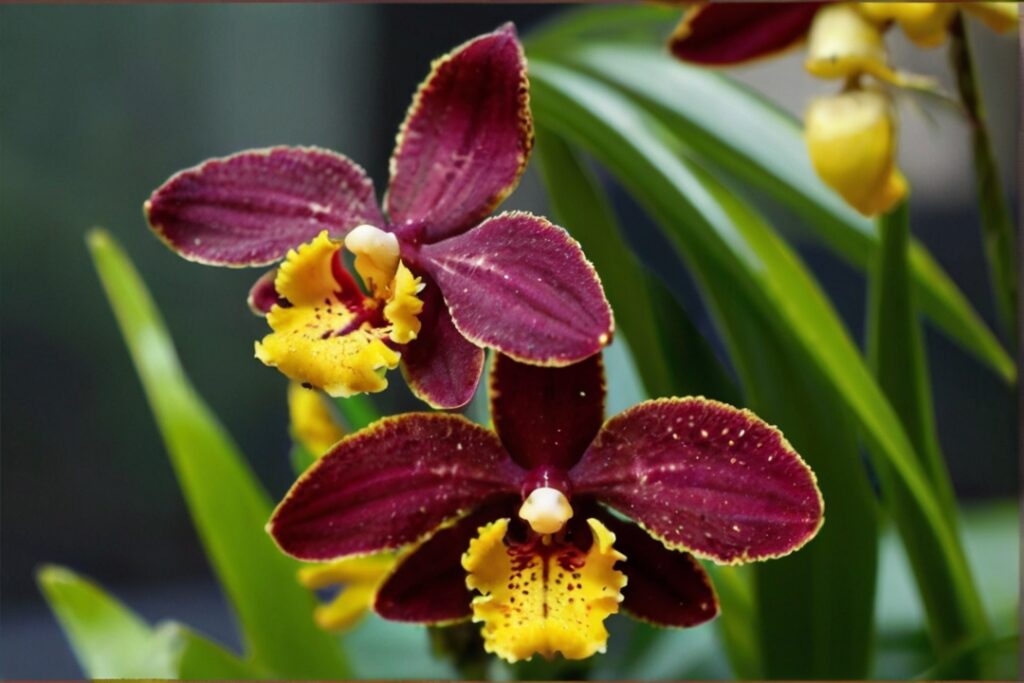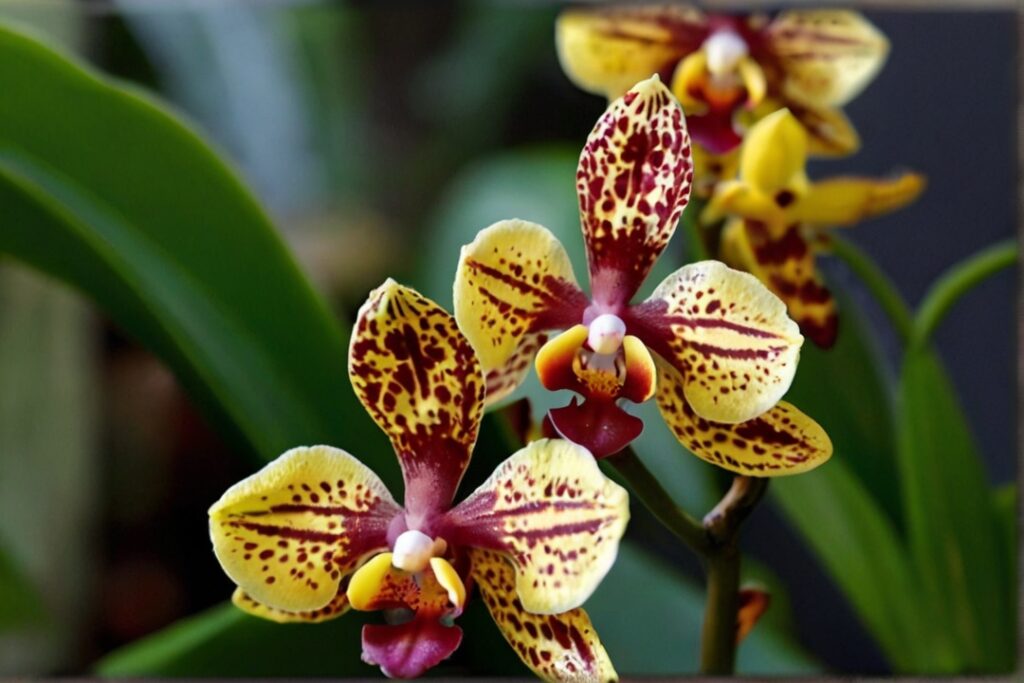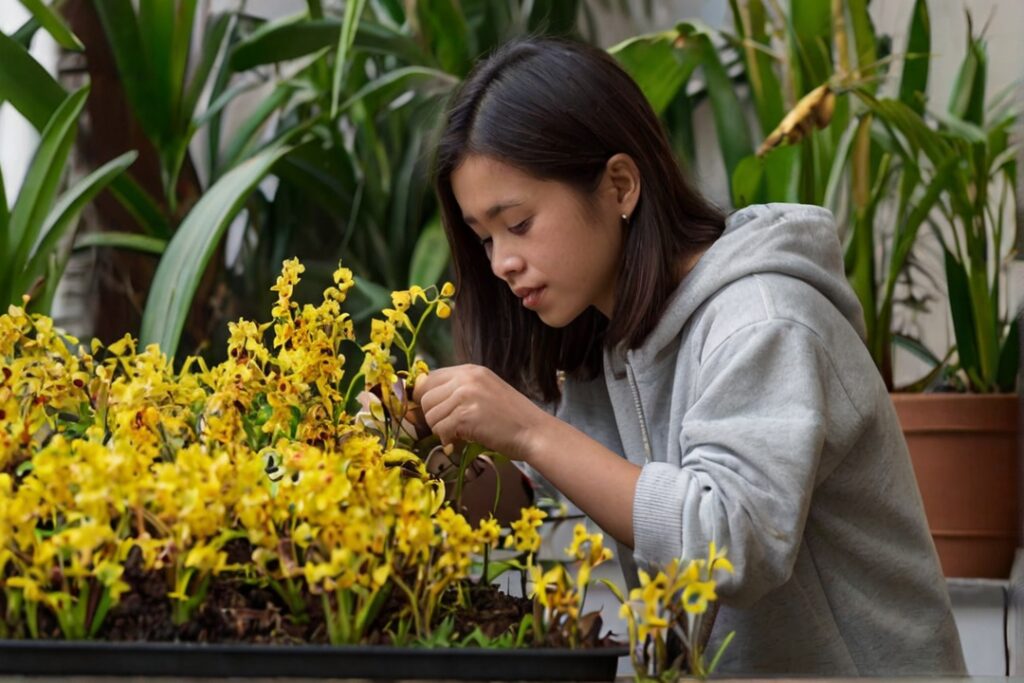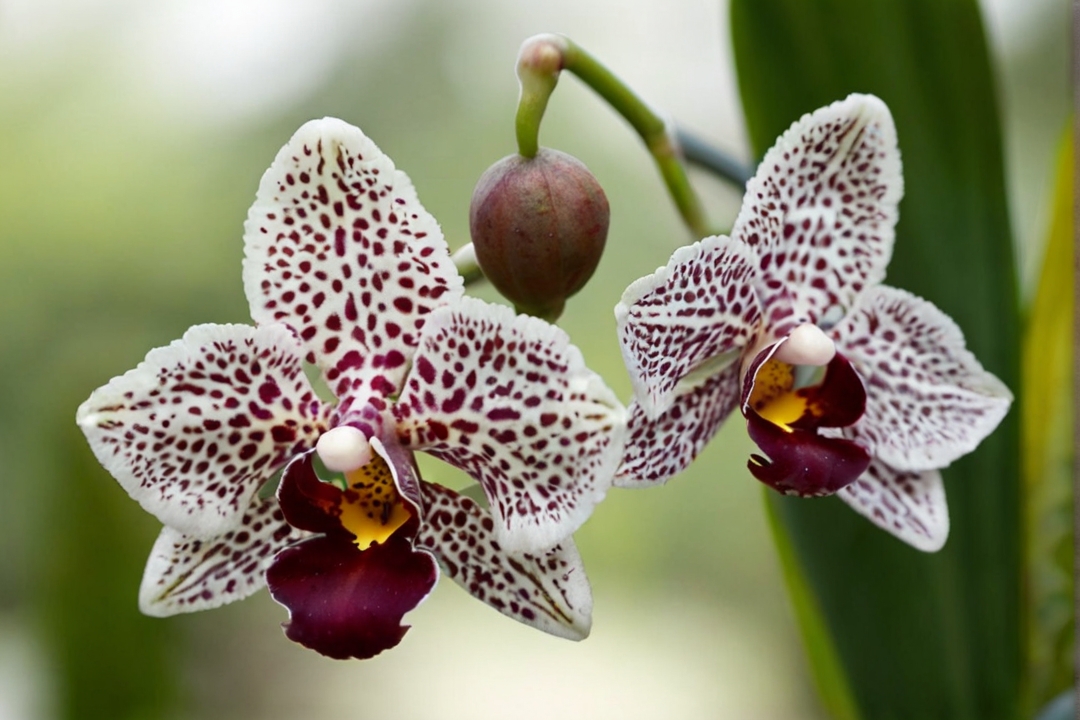Oncidium orchids, also known as “dancing lady” orchids, are popular among orchid enthusiasts due to their unique beauty and elegance. These orchids have a rich history, dating back to the 18th century when they were first discovered in South America. Since then, they have become a favourite among collectors and hobbyists alike.
Table of Contents
- Varieties of Oncidium Orchids
- Ideal Growing Conditions: Light, Temperature, and Humidity
- Choosing the Right Soil and Pot
- Watering and Fertilizing: Tips and Tricks
- Pruning Oncidium Orchids
- Repotting Oncidium Orchids: When and How to Do It
- Common Pests and Diseases
- Propagating Oncidium Orchids
- How to Bloom Oncidium Orchids
- Displaying and Enjoying: Creative Ideas and Inspiration
- Frequently Asked Questions about Oncidium Orchids
One of the most striking features of Oncidium orchids is their vibrant and colourful flowers. They come in various colours, including yellow, orange, red, and pink. The flowers are often intricately patterned and have a delicate, graceful appearance. This makes them a stunning addition to any home or garden.
Varieties of Oncidium Orchids

There are over 300 species of Oncidium orchids, each with unique characteristics and growing habits. Some of the most popular varieties include Oncidium Sharry Baby, Oncidium Twinkle, and Oncidium Gower Ramsey.
Oncidium Sharry Baby
It is known for its sweet chocolate fragrance and ability to produce multiple flower spikes. It has small, compact, deep burgundy flowers with yellow accents. This variety is relatively easy to care for and popular among beginners.
Oncidium Twinkle
It is another popular variety known for its miniature size and prolific blooming. It produces clusters of tiny yellow or white flowers with red or brown markings. This variety is ideal for those with limited space or who want to create a vibrant display of colour.
Oncidium Gower Ramsey
It is a more extensive variety that produces large, showy flowers. The flowers are a bright yellow colour with red or brown markings. This variety requires more care and attention, but the stunning blooms are worth the effort.
Ideal Growing Conditions: Light, Temperature, and Humidity

Oncidium orchids thrive in bright, indirect light. They should be placed near a window where they can receive plenty of natural light but avoid direct sunlight as it can burn the leaves. Suppose you don’t have natural light. In that case, you can use artificial grow lights to provide the necessary light for your orchids.
In terms of temperature, Oncidium orchids prefer a range of 60-80°F (15-27°C) during the day and 50-60°F (10-15°C) at night. They can tolerate slightly higher temperatures during the summer, but it’s essential to provide adequate ventilation to prevent overheating.
Humidity is also an essential factor in the successful growth of Oncidium orchids. They prefer humidity levels between 50-70%. Place a water tray near your orchids or use a humidifier to maintain the ideal humidity. Misting the leaves with water can also help increase humidity.
Choosing the Right Soil and Pot

When choosing the suitable soil and pot for your Oncidium orchids, it’s essential to consider their unique growing habits. These orchids are epiphytic and grow on trees or rocks rather than in soil. Therefore, they require a well-draining potting mix that mimics their natural habitat.
A popular potting mix for Oncidium orchids combines bark chips, sphagnum moss, and perlite. This mix allows good airflow and drainage, preventing the roots from waterlogging. It also provides the necessary nutrients for healthy growth.
When choosing a pot for your orchids, it’s essential to select one that has drainage holes to prevent water from pooling at the bottom. Plastic or clay pots are both suitable options. Still, clay pots tend to dry out faster, benefiting orchids that prefer drier conditions.
Watering and Fertilizing: Tips and Tricks

Proper watering is essential for the health and vitality of Oncidium orchids. These orchids prefer to dry out slightly between waterings, so avoiding overwatering is necessary. Watering frequency will depend on temperature, humidity, and potting mix.
A general rule of thumb is to water your orchids when the top inch of the potting mix feels dry to the touch. When watering, thoroughly saturate the potting mix until water drains out of the bottom of the pot. This ensures that the roots receive adequate moisture.
Regarding fertilizing, Oncidium orchids benefit from regular feeding during the growing season. A balanced orchid fertilizer with a ratio of 20-20-20 is suitable for these orchids. Dilute the fertilizer according to the instructions on the package and apply it every two weeks during the growing season.
Pruning Oncidium Orchids

Pruning is an essential part of maintaining healthy and vibrant Oncidium orchids. It helps promote new growth and prevents overcrowding. Pruning should be done after the orchid has finished blooming.
To prune your orchid, use clean, sharp scissors or pruning shears to remove dead or yellowing leaves or flowers. You can also trim any overgrown or leggy stems to encourage new growth. Be sure to sterilize your tools before and after pruning to prevent the spread of disease.
Repotting Oncidium Orchids: When and How to Do It
Repotting is another crucial aspect of orchid care. Oncidium orchids should be repotted every 1-2 years or when the potting mix starts to break down and become compacted. Repotting should be done in the spring, just before the start of the growing season.
When repotting, gently remove the orchid from its current pot and carefully separate the roots. Trim any dead or damaged roots and place the orchid in a slightly larger pot with fresh potting mix. Be sure to water thoroughly after repotting to help settle the new blend.
Common Pests and Diseases
Aphids on Oncidium Orchids
Aphids can be a nuisance for Oncidium orchids, attacking leaves and flowers. These pests sap essential nutrients, leading to weakened plants. Regular inspections help in early detection. If aphids are spotted, applying neem oil or insecticidal soap effectively controls their population. Consistency in treatment is critical to eradicating these pests.
Mealybugs: The Hidden Threat
With their cotton-like appearance, Mealybugs can infest crevices and undersides of leaves, draining the plant’s vigour. Early detection through routine checks is crucial. Treat infestations with neem oil or alcohol swabs to target and eliminate mealybugs without harming the orchid. Repeated applications may be necessary for complete control.
Spider Mites: The Invisible Foe
Spider mites, though tiny, can cause significant damage by creating delicate webs and speckling leaves with yellow dots. These pests thrive in dry conditions. Increasing humidity and applying miticides or neem oil can deter spider mites. Regular monitoring and treatment are vital to protect your orchids from these pests.
Root Rot: A Water-Related Woe
Root rot is a common issue for Oncidium orchids, often resulting from overwatering. This fungal disease attacks the roots, leading to a decline in health. Ensuring well-draining potting media and avoiding waterlogged conditions are vital preventive measures. Infected plants may require repotting into fresh media after removing affected roots.
Leaf Spots: Fungal Foe
Leaf spots, characterized by discoloured patches on leaves, a signal fungal infection. Poor air circulation and excessive moisture are common culprits. Improving ventilation around your orchids and ensuring leaves remain dry are effective strategies for prevention. Fungicidal sprays can treat infections, but improving care practices is crucial for long-term health.
Propagating Oncidium Orchids
Propagating Oncidium orchids can be a rewarding experience for orchid enthusiasts. There are several methods of propagation, including division, backbulb propagation, and seed propagation.
Division
The division is the most common method of propagation for Oncidium orchids. It involves separating the plant into smaller sections, each with its own set of roots and pseudobulbs. This can be done during repotting when the orchid has become overcrowded.
Backbulb propagation
Backbulb propagation is another method that involves removing the older pseudobulbs from the plant and planting them in a separate pot. These pseudobulbs will eventually develop new growth and can be grown into a new plant.
Seed propagation
Seed propagation is the most challenging and requires more time and patience. It involves collecting the seeds from a mature orchid and sowing them in a sterile growing medium. The seeds will then germinate and develop into new plants over time.
How to Bloom Oncidium Orchids
Light Requirements
Provide bright, indirect light. Oncidium orchids require more light than many other orchid species but should not be exposed to direct sunlight.
Temperature Conditions
Ensure cooler nighttime temperatures between 55 to 60 degrees Fahrenheit (13 to 15.5 degrees Celsius) and warmer temperatures during the day. These fluctuations are crucial for encouraging blooming.
Watering and Humidity
Maintain high humidity levels and consistent watering practices, allowing the growing medium to dry slightly between waterings. Overwatering or under-watering can affect blooming.
Fertilization
A balanced orchid fertilizer provides essential nutrients, especially during the growing season. This supports both growth and blooming.
Post-Bloom Care
After blooming, prune back the flower stems to stimulate future blooming. This also helps redirect the plant’s energy towards new growth and flower production.
Repotting and Medium
Repot in a well-draining medium when necessary, typically every 1-2 years or when the medium breaks down. A fresh medium can enhance plant health and blooming capability.
Bloom Cycle Awareness
Understand that Oncidium orchids typically bloom in late summer (around August) and can last for several weeks. Anticipate this cycle for optimal care.
Pest and Disease Management
Regularly inspect for signs of pests and diseases. Healthy plants are more likely to bloom well.
Environmental Simulation
Try to mimic the orchid’s natural environment as closely as possible, considering factors like light, temperature, and humidity for optimal blooming.
Patience and Observation
Be patient and observe your plant’s response to care adjustments. Oncidium orchids may take time to adapt to changes and initiate blooming.
Implementing these practices can significantly increase your Oncidium orchids’ chances of blooming and maintaining health throughout their bloom cycle.
Displaying and Enjoying: Creative Ideas and Inspiration
Oncidium orchids can be displayed creatively to enhance your home decor. One popular option is to place them in a decorative pot or vase and use them as a centrepiece on a dining table or mantel. You can also hang them on a macrame hanger near a window to create a stunning cascading flower display.
Another creative idea is incorporating Oncidium orchids into a terrarium or glass container garden. This allows you to create a mini-ecosystem for your orchids, complete with moss, rocks, and other decorative elements. This can be a great way to showcase their unique beauty and create a focal point in any room.
If you have limited space, you can display your Oncidium orchids on a windowsill or shelf using small pots or hanging baskets. This allows you to enjoy their vibrant blooms without taking up too much space.
Frequently Asked Questions about Oncidium Orchids
Q: How often should I water my Oncidium orchids?
A: Oncidium orchids prefer to dry out slightly between waterings. Water them when the top inch of the potting mix feels dry to the touch.
Q: How do I know if my orchid is getting enough light?
A: Oncidium orchids thrive in bright, indirect light. If the leaves are dark green and floppy, it may indicate that your orchid is not receiving enough light. If the leaves are pale or yellow, it may be getting too much light.
Q: How often should I fertilize my Oncidium orchids?
A: Oncidium orchids benefit from regular feeding during the growing season. Apply a balanced orchid fertilizer every two weeks, following the instructions on the package.
Q: When should I report my Oncidium orchids?
A: Oncidium orchids should be repotted every 1-2 years or when the potting mix starts to break down and compact. Repotting should be done in the spring, just before the start of the growing season.
Q: How do I prevent pests and diseases in my Oncidium orchids?
A: Regularly inspect your orchids for any signs of pests or diseases. Provide adequate airflow around your orchids and avoid overwatering to prevent fungal infections. If you notice any pests, use natural remedies such as neem oil or insecticidal soap to control the infestation.
In conclusion, Oncidium orchids are a beautiful and elegant choice for any orchid enthusiast. With their vibrant colours, long-lasting blooms, and unique growing habits, they will surely add a touch of beauty to any home or garden. By providing the ideal growing conditions, choosing suitable soil and pot, and following proper care techniques, you can enjoy healthy and vibrant Oncidium orchids for years.

